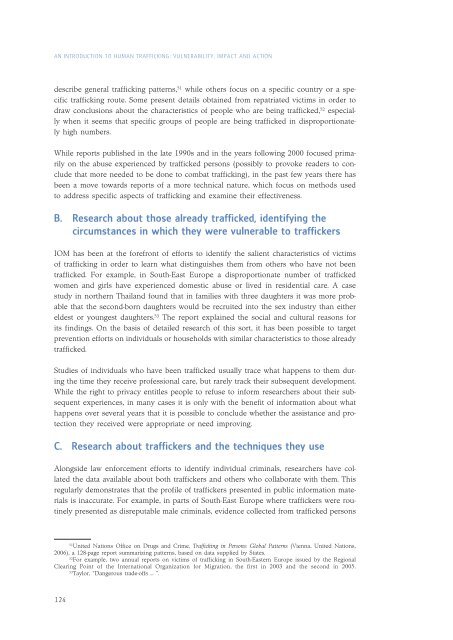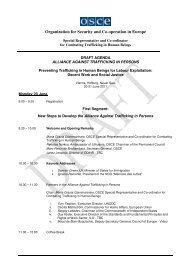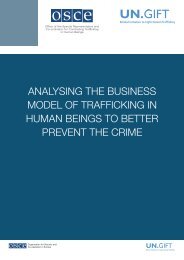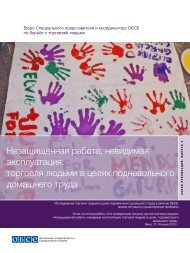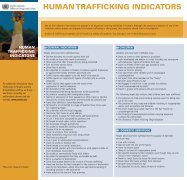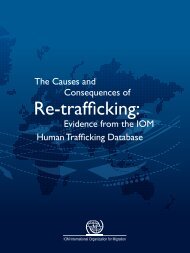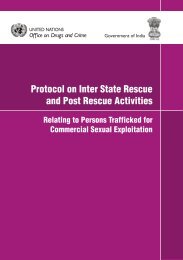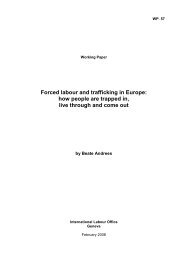An Introduction to Human Trafficking - United Nations Office on ...
An Introduction to Human Trafficking - United Nations Office on ...
An Introduction to Human Trafficking - United Nations Office on ...
Create successful ePaper yourself
Turn your PDF publications into a flip-book with our unique Google optimized e-Paper software.
AN INTRODUCTION TO HUMAN TRAFFICKING: VULNERABILITY, IMPACT AND ACTION<br />
describe general trafficking patterns, 51 while others focus <strong>on</strong> a specific country or a specific<br />
trafficking route. Some present details obtained from repatriated victims in order <str<strong>on</strong>g>to</str<strong>on</strong>g><br />
draw c<strong>on</strong>clusi<strong>on</strong>s about the characteristics of people who are being trafficked, 52 especially<br />
when it seems that specific groups of people are being trafficked in disproporti<strong>on</strong>ately<br />
high numbers.<br />
While reports published in the late 1990s and in the years following 2000 focused primarily<br />
<strong>on</strong> the abuse experienced by trafficked pers<strong>on</strong>s (possibly <str<strong>on</strong>g>to</str<strong>on</strong>g> provoke readers <str<strong>on</strong>g>to</str<strong>on</strong>g> c<strong>on</strong>clude<br />
that more needed <str<strong>on</strong>g>to</str<strong>on</strong>g> be d<strong>on</strong>e <str<strong>on</strong>g>to</str<strong>on</strong>g> combat trafficking), in the past few years there has<br />
been a move <str<strong>on</strong>g>to</str<strong>on</strong>g>wards reports of a more technical nature, which focus <strong>on</strong> methods used<br />
<str<strong>on</strong>g>to</str<strong>on</strong>g> address specific aspects of trafficking and examine their effectiveness.<br />
B. Research about those already trafficked, identifying the<br />
circumstances in which they were vulnerable <str<strong>on</strong>g>to</str<strong>on</strong>g> traffickers<br />
IOM has been at the forefr<strong>on</strong>t of efforts <str<strong>on</strong>g>to</str<strong>on</strong>g> identify the salient characteristics of victims<br />
of trafficking in order <str<strong>on</strong>g>to</str<strong>on</strong>g> learn what distinguishes them from others who have not been<br />
trafficked. For example, in South-East Europe a disproporti<strong>on</strong>ate number of trafficked<br />
women and girls have experienced domestic abuse or lived in residential care. A case<br />
study in northern Thailand found that in families with three daughters it was more probable<br />
that the sec<strong>on</strong>d-born daughters would be recruited in<str<strong>on</strong>g>to</str<strong>on</strong>g> the sex industry than either<br />
eldest or youngest daughters. 53 The report explained the social and cultural reas<strong>on</strong>s for<br />
its findings. On the basis of detailed research of this sort, it has been possible <str<strong>on</strong>g>to</str<strong>on</strong>g> target<br />
preventi<strong>on</strong> efforts <strong>on</strong> individuals or households with similar characteristics <str<strong>on</strong>g>to</str<strong>on</strong>g> those already<br />
trafficked.<br />
Studies of individuals who have been trafficked usually trace what happens <str<strong>on</strong>g>to</str<strong>on</strong>g> them during<br />
the time they receive professi<strong>on</strong>al care, but rarely track their subsequent development.<br />
While the right <str<strong>on</strong>g>to</str<strong>on</strong>g> privacy entitles people <str<strong>on</strong>g>to</str<strong>on</strong>g> refuse <str<strong>on</strong>g>to</str<strong>on</strong>g> inform researchers about their subsequent<br />
experiences, in many cases it is <strong>on</strong>ly with the benefit of informati<strong>on</strong> about what<br />
happens over several years that it is possible <str<strong>on</strong>g>to</str<strong>on</strong>g> c<strong>on</strong>clude whether the assistance and protecti<strong>on</strong><br />
they received were appropriate or need improving.<br />
C.—Research about traffickers and the techniques they use<br />
Al<strong>on</strong>gside law enforcement efforts <str<strong>on</strong>g>to</str<strong>on</strong>g> identify individual criminals, researchers have collated<br />
the data available about both traffickers and others who collaborate with them. This<br />
regularly dem<strong>on</strong>strates that the profile of traffickers presented in public informati<strong>on</strong> materials<br />
is inaccurate. For example, in parts of South-East Europe where traffickers were routinely<br />
presented as disreputable male criminals, evidence collected from trafficked pers<strong>on</strong>s<br />
51<br />
<str<strong>on</strong>g>United</str<strong>on</strong>g> <str<strong>on</strong>g>Nati<strong>on</strong>s</str<strong>on</strong>g> <str<strong>on</strong>g>Office</str<strong>on</strong>g> <strong>on</strong> Drugs and Crime, <str<strong>on</strong>g>Trafficking</str<strong>on</strong>g> in Pers<strong>on</strong>s: Global Patterns (Vienna, <str<strong>on</strong>g>United</str<strong>on</strong>g> <str<strong>on</strong>g>Nati<strong>on</strong>s</str<strong>on</strong>g>,<br />
2006), a 128-page report summarizing patterns, based <strong>on</strong> data supplied by States.<br />
52<br />
For example, two annual reports <strong>on</strong> victims of trafficking in South-Eastern Europe issued by the Regi<strong>on</strong>al<br />
Clearing Point of the Internati<strong>on</strong>al Organizati<strong>on</strong> for Migrati<strong>on</strong>, the first in 2003 and the sec<strong>on</strong>d in 2005.<br />
53<br />
Taylor, “Dangerous trade-offs … ”.<br />
124


